The 21 gram (0.7 oz) moon rock is only the second* out of the 842 pounds (382 kg) of lunar samples collected by the Apollo astronauts between 1969 and 1972 to be launched back into space. Its journey is planned as a round trip — it will return to Earth as it came with a future shuttle mission — in part to symbolize NASA's current effort to return astronauts to the Moon.
Not quite "Operation Moon Rock" but still a secret
To keep the moon rock's launch a secret, NASA limited the number of people who were in the know, including within the special laboratory where the agency keeps and prepares the moon rocks for scientific study, educational display, and the occasional trip into space.
The agency did not however, circumvent its established system for readying items to go to orbit.
"This was not a deeply organized 'Operation Moon Rock' project," explained Bob Jacobs, NASA's acting assistant administrator for public affairs, in an e-mail interview with collectSPACE. "It is not unusual for us to manifest items for various education and outreach purposes. We followed the same procedures."
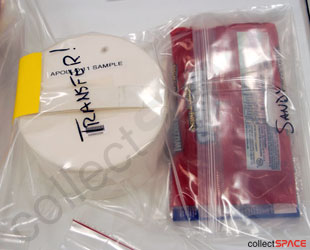
Rock and candy, both ISS-bound. (Credit: NASA/collectSPACE) |
Indeed, as pre-launch photos obtained by collectSPACE reveal, the rock was prepared and packaged alongside other supplies heading to the station aboard space shuttle Discovery's STS-119 mission. In one photo, a package of cherry licorice candy intended for a station crew member is lying by the moon rock carrier's side.
Picking a "return sample" to return to space
Although procedures existed to launch items to the space station, the same could not be said for how to prepare — or pick — a moon rock to go back to space.
The idea was first put forward by the few among NASA's public affairs staff who were aware of the project to Dr. Gary Lofgren, a senior planetary scientist and the Lunar Curator at the Lunar Receiving Laboratory at the Johnson Space Center in Houston. Lofgren recounted what his first reactions were of the idea to collectSPACE.
"Ooh, that's an interesting idea. I wonder if we should do that? Hmm... well, that might be good publicity," recalled Lofgren.
It wasn't however, his decision to make.
"We have a charter committee of scientists that reviews all the requests for lunar samples from a scientific point of view. If they don't approve of it, it doesn't happen," he explained. "In the end, they decided to go ahead and do it."
Lofgren did choose the rock to be used.
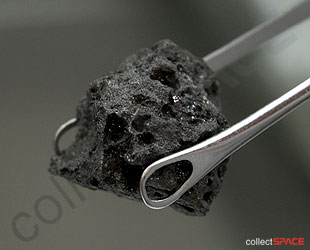
10072,15 - a smaller piece of this same rock that flew to the International Space Station. (Credit: collectSPACE) |
NASA desired the sample to be from Apollo 11, the first lunar landing, which brought back a total of 50 rocks, most of which are still kept in pristine condition inside the receiving lab. The samples that are not, which have been sent out for scientific study and in the process exposed to air, are held separate when received back by Lofgren and his colleagues inside the laboratory. These samples are referred to as "return samples".
"We didn't want to contaminate a pristine sample for this," Lofgren described. "The nicest piece to use for this, size-wise and for its looks, was this particular rock. There was nothing magic about it other than it was the nicest of the returned rock."
The rock Lofgren selected to be launched to the station, referred to by an ID number — 10072,41 — was originally part of a sample collected by Neil Armstrong toward the end of his and Buzz Aldrin's two and half hour historic moonwalk on July 20, 1969.
"This was part of the batch of rocks that Neil collected all at once when he just sort of threw things into a box," said Lofgren, referring to a collecting task that was described in the crew's checklist as the "bulk sample".
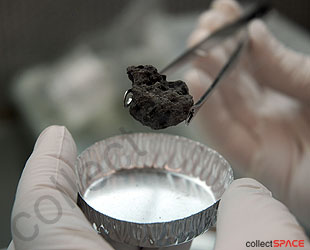
Lunar basalt resembles Hawaiian lava. (Credit: collectSPACE) |
The chosen rock also bares a resemblance to one of the very first rocks scooped up off the surface, a "contigency sample" should something have happened necessitating the astronauts to leave the Moon quickly.
"[10072,41] is a rather standard kind of basalt, nothing really special about it. It is very similar to the contingency sample, one of the first ones they collected. It looks very similar to this," share Lofgren.
In comparison to Earth-based geology, the moon rock is similar to lava found in Hawaii — only the lava that formed the lunar basalt flowed much more like water than the lava seen on Earth.
Sealed for space flight
Though 10072,41 was already exposed to air, "somewhat contaminating" it for further study, it still needed to be protected during its launch and time on the ISS. Lofgren selected a case originally designed for terrestrial exhibits.
"This is the kind of container we had made for us way back in the beginning for displaying lunar samples. It was the very first case design," Lofgren explained. "We put little pieces of shrink tubing over each of its [rock stand's] arms and then bent them down, so they would hold the rock securely. So the rock is actually held quite securely in the case."
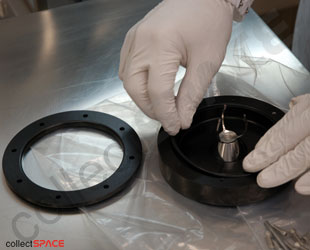
Assemblying a case like the one that flew to hold the moon rock in place in space. (Credit: collectSPACE) |
The arms should prevent the moon rock from floating free in weightlessness and the eight screws that keep the dome-shaped case closed should keep out any curious hands.
"I told public affairs that the astronauts better not open it up and they understand that," said Lofgren. "I'm sure they would have an Allen wrench that they could use to open it up, if they chose to do that. I'm not up there to watch them, but I don't think they will."
The case is more of a deterrant though, then a protective enclosure.
"It would take a lot to chip it, it is not a soft rock," Lofgren advised, adding that the dome won't protect the rock from any ultraviolet ray exposure. "There's no UV protection. The sample suffered far more UV on the Moon than it will ever see here on Earth."
Stowed aboard Discovery in one of its middeck lockers during the STS-119 launch on March 15, 2009, the moon rock inside its case was in turn packaged inside a padded container labeled "Apollo 11 sample". Once docked at the station, Discovery's crew transferred the rock aboard the ISS, where it has been ever since in preparation for the anniversary.
Symbolic sample
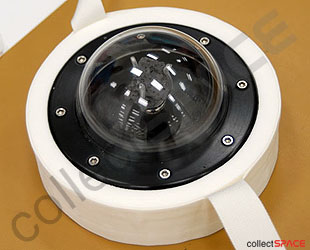
The rock will be used to represent NASA's past, present and future (Credit: NASA/collectSPACE) |
For NASA, the opportunity to fly a moon rock offered the chance to span its rich history of space exploration.
"We knew we wanted to have the Expedition 20 crew on board the ISS play a role in the Apollo 40th anniversary activities and we thought this was an interesting way to tie the recognition of the past to the promise of the future," said Jacobs.
After completing the assembly of the space station next year — including launching a module named "Tranquility" after the base where Apollo 11 landed — NASA plans to retire its space shuttle fleet and replace it with a vehicle and launch system that could return humans to the Moon.
As to what the astronauts will do with the moon rock to share that plan and promise, Jacobs isn't saying. Not even Neil Armstrong or his Apollo 11 crewmates were told of the moon rock's launch.
"You will have to watch the program tonight to see what happens next."
NASA's "Celebrate the Apollo Program" presentation on July 20 at the National Air and Space Museum is not open to the public but will be broadcast live on NASA TV and on the space agency's website.
This article was corrected after it was first published to acknowledge that the Apollo 16 mission in 1972 returned to the Moon's surface a lunar sample collected earlier by the Apollo 12 crew as part of an investigation into the Moon's magnetic field.
